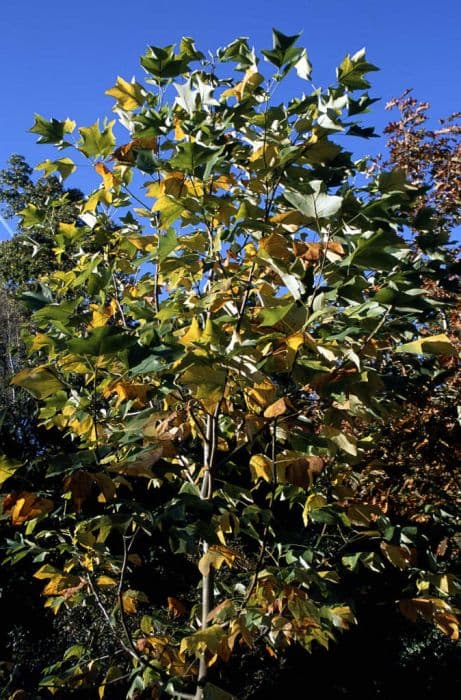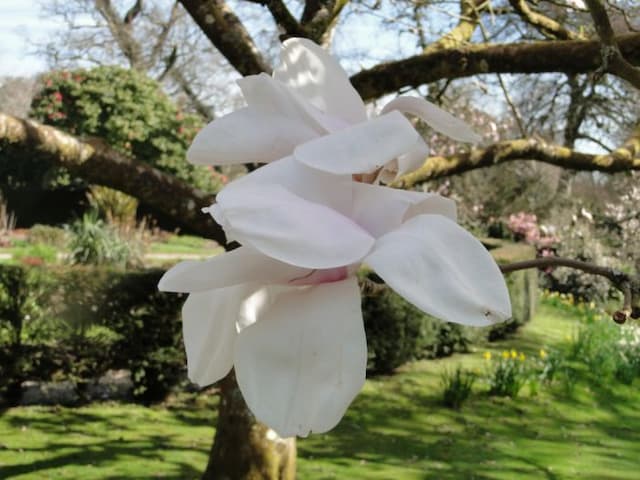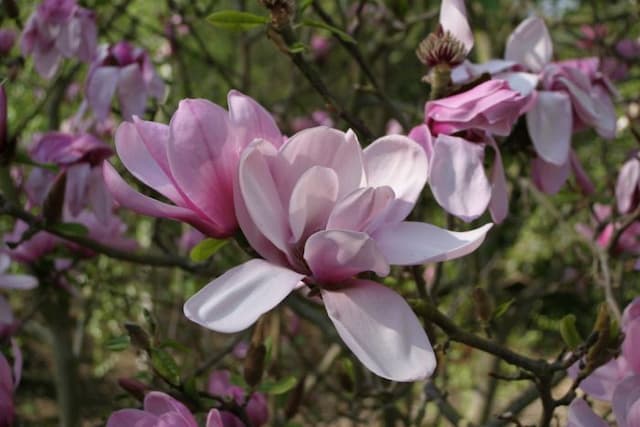Magnolia Magnolia 'Phillip Tregunna'

ABOUT
The Magnolia 'Phillip Tregunna' is a cultivar known for its stunning and large flowers, which are among the most striking features. These flowers are typically cup-shaped and unfold to a more open form as they mature. The petals are thick and waxy, coming in shades ranging from creamy white to soft pinks, often with a blush of purple at the base, contributing to an overall elegant appearance. The foliage of the 'Phillip Tregunna' is another noteworthy characteristic. It bears glossy green leaves that provide a luscious backdrop to the showy blossoms, with the leaves sometimes having a rusty or brownish tinge on their undersides, offering a subtle contrast in color. The plant exhibits a spreading habit, with its branches gracefully reaching outward. Moreover, the tree's bark offers additional visual interest, being grayish-brown and developing a slightly furrowed texture over time, which adds to the plant's rustic charm. The overall look of the Magnolia 'Phillip Tregunna' is one of classic beauty and sophistication, lending it the capacity to be a focal point in gardens where its decorative features can be fully appreciated throughout its blooming season.
About this plant
 Names
NamesFamily
Magnoliaceae
Synonyms
Phillip Tregunna Magnolia
Common names
Magnolia 'Phillip Tregunna'.
 Toxicity
ToxicityTo humans
The Magnolia, including cultivars like 'Phillip Tregunna,' is generally considered non-toxic to humans. However, as with any plant, individual sensitivities or allergic reactions might occur when handling or ingesting plant material. If symptoms such as skin irritation, stomach upset, or allergic reactions develop, medical attention should be sought.
To pets
Magnolia plants are generally considered to be of low toxicity to pets. While they are not commonly associated with serious poisoning, consumption of large quantities of leaves or flowers might lead to gastrointestinal upset in some pets, like vomiting or diarrhea. If your pet exhibits these symptoms after ingesting parts of a Magnolia, it is advisable to consult a veterinarian.
 Characteristics
CharacteristicsLife cycle
Perennials
Foliage type
Deciduous
Color of leaves
Green
Flower color
Pink
Height
20 feet (6 meters)
Spread
10 feet (3 meters)
Plant type
Tree
Hardiness zones
5
Native area
Cultivar
Benefits
 General Benefits
General Benefits- Attractive Flowers: The Magnolia 'Phillip Tregunna' produces large, showy flowers that can add aesthetic value to any garden or landscape.
- Scent: The blooms are often fragranced and can provide a pleasing scent to the surrounding area.
- Shade Provider: As a tree, it can offer shade in gardens, reducing local temperature and providing a cool area to relax.
- Seasonal Interest: This magnolia has a seasonal impact with its flowers in spring and sometimes additional blooming in summer, along with changing leaf colors in autumn.
- Habitat Support: The tree can provide habitat and food for various wildlife, including birds, bees, and butterflies.
- Landscape Design: It's often used as a focal point in landscape designs due to its striking appearance.
- Privacy: When planted in groups, Magnolia 'Phillip Tregunna' can create a privacy screen or hedge.
- Property Value: Attractive landscaping with feature plants like this magnolia can potentially increase property value.
 Medical Properties
Medical PropertiesThis plant is not used for medical purposes.
 Air-purifying Qualities
Air-purifying QualitiesThis plant is not specifically known for air purifying qualities.
 Other Uses
Other Uses- Magnolia 'Phillip Tregunna' can be used in woodworking projects for its moderate hardness and fine grain to create decorative veneer and small wooden objects.
- Extracts from the Magnolia flowers can be used in perfumery to create floral scents due to its strong and pleasant fragrance.
- The petals of the Magnolia can be crystallized and used as edible decorations for desserts, adding both a floral aesthetic and a subtle flavor.
- Dried Magnolia leaves can be incorporated into wreaths and garlands for rustic home decor, especially popular during festive seasons.
- The leaves can also be used as a natural dye in textile art, producing colors ranging from green to brown depending on the mordant used.
- Magnolia wood is sometimes used to manufacture musical instruments like flutes or small drums because of its acoustic properties.
- Pressed Magnolia flowers can make beautiful additions to handmade paper, enhancing its texture and visual appeal for arts and crafts.
- In landscape design, the tree is utilized for its shape and evergreen nature to create visually striking privacy screens or hedges.
- Magnolia 'Phillip Tregunna' can be grown in large containers as an ornamental patio tree, where space in the garden is limited.
- Photographers and visual artists might use the striking blooms of the Magnolia as subjects for prints, calendars, or inspiration for various art mediums.
Interesting Facts
 Feng Shui
Feng ShuiThe Magnolia is not used in Feng Shui practice.
 Zodiac Sign Compitability
Zodiac Sign CompitabilityThe Magnolia is not used in astrology practice.
 Plant Symbolism
Plant Symbolism- Nobility: The magnolia is often associated with nobility due to its impressive and regal appearance.
- Purity and Dignity: The white flowers of many magnolia varieties symbolize purity and dignity, reflecting the plant's elegant stature.
- Perseverance: Magnolias are known to be hardy and can thrive for many years, making them a symbol of perseverance.
- Beauty: With its large, showy flowers, the magnolia is a common symbol of beauty and splendor in nature.
- Feminine Qualities: The magnolia’s soft petals and strong presence is seen as embodying feminine strength and gentleness.
- Hospitality: In the American South, the magnolia is a symbol of warm hospitality and welcoming.
- Longevity: Some magnolia trees can live for over a century, leading them to symbolize longevity and endurance.
- Peace and Tranquility: The serene presence of the magnolia tree and its tranquil flowers often represent peace and calmness.
 Water
WaterThe Magnolia requires consistent moisture, especially when young. During the growing season, water deeply once a week, providing about 1.5 to 2 gallons for younger trees and up to 4 gallons for mature trees, depending on the size and soil conditions. Avoid overwatering, as Magnolias do not tolerate soggy soil. Ensure the surrounding soil is moist but not waterlogged. In dry spells or extreme heat, increase watering frequency to maintain adequate hydration.
 Light
LightMagnolias thrive in full sunlight to partial shade. They perform best when planted in a location where they can receive at least 4 to 6 hours of direct sunlight daily. The ideal spot would be one that offers morning sunlight with some dappled shade in the afternoon to protect from the intense heat.
 Temperature
TemperatureMagnolias are hardy and can tolerate a range of temperatures but prefer a consistent climate. They can withstand minimum temperatures down to about 0 degrees Fahrenheit, while the maximum they can tolerate without stress is around 90 degrees Fahrenheit. Ideally, the Magnolia enjoys temperatures between 70 and 85 degrees Fahrenheit during the growing season.
 Pruning
PruningPruning Magnolias is typically done to maintain shape and remove any dead or damaged branches. The best time to prune is in late winter or early spring, before new growth begins. Prune sparingly, as Magnolias do not require heavy pruning and can be sensitive to excessive cutting. Annually inspect the tree, and only prune as necessary to maintain its health and appearance.
 Cleaning
CleaningAs needed
 Soil
SoilMagnolias require well-drained, rich soil with a slightly acidic pH between 5.5 and 6.5. A mix of loam, peat moss, and compost can create an ideal environment for Magnolia 'Phillip Tregunna'.
 Repotting
RepottingMagnolia trees, such as 'Phillip Tregunna', typically do not need to be repotted often as they are usually planted directly in the ground. If grown in containers, they might need repotting every few years to refresh the soil.
 Humidity & Misting
Humidity & MistingMagnolias, including the 'Phillip Tregunna', prefer moderate humidity levels but are adaptable to the ambient outdoor humidity in most climates where they thrive.
 Suitable locations
Suitable locationsIndoor
Ensure bright, indirect light and room to grow.
Outdoor
Plant in well-draining soil with sun to partial shade.
Hardiness zone
7-9 USDA
 Life cycle
Life cycleThe life cycle of Magnolia 'Phillip Tregunna', like other magnolia varieties, begins with germination, which occurs when its seeds are sown in fertile, well-drained soil with adequate warmth and moisture. Following germination, the seedling stage involves initial development of roots and shoots, setting the foundation for future growth. As it enters the juvenile phase, it starts to form a more defined structure with branching, and leaves become more characteristic of magnolias. Upon reaching maturity, 'Phillip Tregunna' magnolia produces large, fragrant flowers, typically white or cream with purple or pink at the base, which then lead to the development of cone-like fruit bearing red seeds. After flowering, as the plant ages, it enters a phase of senescence where growth slows and the plant's vitality eventually wanes. Finally, with the natural end of its life cycle, the plant may die, leaving its seeds to perpetuate a new generation if conditions allow.
 Propogation
PropogationPropogation time
Spring-Early Summer
The Magnolia 'Phillip Tregunna' is most effectively propagated through the method of softwood cuttings. This technique is typically carried out in late spring to early summer when new growth is still flexible and has not yet hardened. To propagate using this method, a cutting of about 4 to 6 inches (10 to 15 centimeters) is taken from a healthy branch, ensuring that at least two sets of leaves are present. The lower set of leaves is removed, and the cut end is dipped into a rooting hormone to encourage root development. The cutting is then inserted into a pot filled with a well-draining potting mix, ensuring that the nodes where the leaves were removed are buried as they are where roots will likely form. The pot should be placed in a warm location with indirect light and kept consistently moist until roots have developed, which can be confirmed by gently tugging on the cutting to feel for resistance.









![Magnolia [Felix Jury]](/_next/image?url=https%3A%2F%2Fplants-admin.emdemapps.com%2Fimages%2Fplants%2F%2Fimages%2F604b61a0b23b7.png&w=640&q=75)